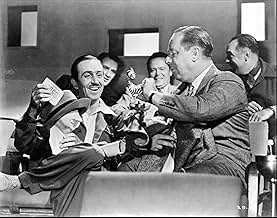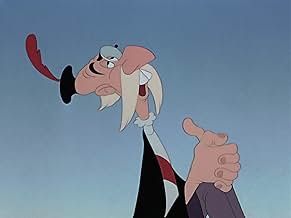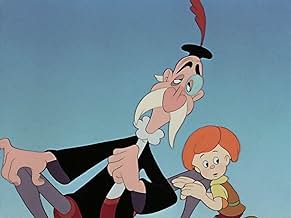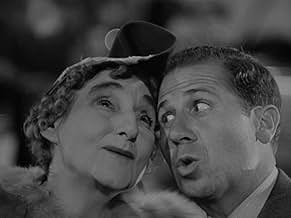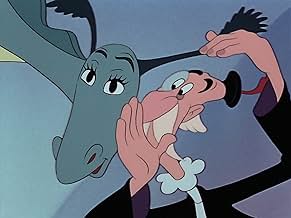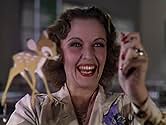PUNTUACIÓN EN IMDb
6,7/10
4,1 mil
TU PUNTUACIÓN
Un dragón se distingue del resto de su especie porque no se siente malvado ni violento. Antes que agredir a los seres humanos, prefiere entretenerse recitando poesía o cantando canciones.Un dragón se distingue del resto de su especie porque no se siente malvado ni violento. Antes que agredir a los seres humanos, prefiere entretenerse recitando poesía o cantando canciones.Un dragón se distingue del resto de su especie porque no se siente malvado ni violento. Antes que agredir a los seres humanos, prefiere entretenerse recitando poesía o cantando canciones.
- Premios
- 1 premio en total
Norman Ferguson
- Norm Ferguson
- (as Norm Ferguson)
Jim Luske
- Jimmy - Baby Weems Model
- (as Jimmy Luske)
Hamilton MacFadden
- Hamilton MacFadden
- (as Hamilton Mac Fadden)
Ernie Alexander
- Baby Weems' Father
- (voz)
- (sin acreditar)
Reseñas destacadas
Humorist Robert Benchley is at home. His wife convinces him to sell the rights for his story 'The Reluctant Dragon' to Walt Disney. She drags him to the studio and leaves him there. He wanders around the studio and discovers the animation process along the way. Finally he meets Walt Disney himself.
This starts as a black and white live action fictional drama. The fact that it's not animation made it less than successful originally. However it's fascinating to see where Disney began and what it looked like. It's a studio tour dressed up as a little story. This is terrific as a time capsule and a fun way to see how it was made. This is probably a good movie to show new hires at the time. After 25 minutes, the movie turns into technicolor with some animation. Goofy has a cartoon about how to ride a horse. The final section has the Reluctant Dragon cartoon. This movie has a bit of historical values but as a story, this is rather bland.
This starts as a black and white live action fictional drama. The fact that it's not animation made it less than successful originally. However it's fascinating to see where Disney began and what it looked like. It's a studio tour dressed up as a little story. This is terrific as a time capsule and a fun way to see how it was made. This is probably a good movie to show new hires at the time. After 25 minutes, the movie turns into technicolor with some animation. Goofy has a cartoon about how to ride a horse. The final section has the Reluctant Dragon cartoon. This movie has a bit of historical values but as a story, this is rather bland.
This little classic spends just short of an hour touring the Disney Studios in the company of Robert Benchley, the humorist who acts like a big kid in a candy store (and is thus the perfect guide for something like this).
We see how the cartoons are made, moving from the recording studio - where the real-life voices of Donald Duck and Clara Cluck sing an aria - through to clay models of the characters to be animated - the sound effects dept. (we see the full Casey Junior sequence, some of which ended up in 1941's 'Dumbo') - the scenario department (we see a whole cartoon - Baby Weems - in storyboard format) - the animation department (we see a cartoon feature on riding a horse, and see Donald Duck showing us how he walks) - and much more. There's also a neat segue from black and white to Technicolor.
'The Reluctant Dragon' is a book which Benchley hopes to pitch to Disney, only to find the film has already been made; the last 20 minutes of this feature is the cartoon about the (rather camp) dragon, and a classic bit of Disney work.
The whole movie is engrossing and a fantastic overview of the state-of-the-art work being done by the Disney Studios at the beginning of the 40s.
We see how the cartoons are made, moving from the recording studio - where the real-life voices of Donald Duck and Clara Cluck sing an aria - through to clay models of the characters to be animated - the sound effects dept. (we see the full Casey Junior sequence, some of which ended up in 1941's 'Dumbo') - the scenario department (we see a whole cartoon - Baby Weems - in storyboard format) - the animation department (we see a cartoon feature on riding a horse, and see Donald Duck showing us how he walks) - and much more. There's also a neat segue from black and white to Technicolor.
'The Reluctant Dragon' is a book which Benchley hopes to pitch to Disney, only to find the film has already been made; the last 20 minutes of this feature is the cartoon about the (rather camp) dragon, and a classic bit of Disney work.
The whole movie is engrossing and a fantastic overview of the state-of-the-art work being done by the Disney Studios at the beginning of the 40s.
I happened upon this film during a late night when nothing else was on TV, and couldn't have been happier that I came across it.
In this, we're taken behind-the-scenes of Disney studios circa 1941, and given a humorous (and, I'm sure, highly fictionalized) tour of the studio and its various departments. While I've always been a fan of Disney's animation, I'd never been given a glimpse of the animators themselves, and I always thought that they deserved to be as well known as the Warner Brothers stable of talent. Well, here they're given a chance to hog the spotlight (as Disney himself doesn't show up until the final few moments of the film) and show off their talents.
Not only is this a good chance for you to see how some of your Disney favorites were brought to screen, the linking device with comic Robert Benchley is charming throughout, and the attitude is more than a little self-deprecating (playing up the notion that one is indoctrinated into the "Disney way of life" in working for the Mouse, Benchley's guide is portrayed as a militarily-garbed, wormy little walking Disney Rule Book). The animation itself is great (as is usual for Disney of this vintage) and the live-action work is funny in a way that most Disney live-action works aren't. All of this adds up to a most rewarding, and highly neglected, classic from the Vaults of Disney.
In this, we're taken behind-the-scenes of Disney studios circa 1941, and given a humorous (and, I'm sure, highly fictionalized) tour of the studio and its various departments. While I've always been a fan of Disney's animation, I'd never been given a glimpse of the animators themselves, and I always thought that they deserved to be as well known as the Warner Brothers stable of talent. Well, here they're given a chance to hog the spotlight (as Disney himself doesn't show up until the final few moments of the film) and show off their talents.
Not only is this a good chance for you to see how some of your Disney favorites were brought to screen, the linking device with comic Robert Benchley is charming throughout, and the attitude is more than a little self-deprecating (playing up the notion that one is indoctrinated into the "Disney way of life" in working for the Mouse, Benchley's guide is portrayed as a militarily-garbed, wormy little walking Disney Rule Book). The animation itself is great (as is usual for Disney of this vintage) and the live-action work is funny in a way that most Disney live-action works aren't. All of this adds up to a most rewarding, and highly neglected, classic from the Vaults of Disney.
I just loved this cartoon, and I hope that video stores have it, so that I may rent it or buy it. what I liked about this cartoon was the voices and the songs that the dragon, esp. the song that the dragon sang while he was taking a shower; and my favorite scenes were when the dragon and sir giles were in the cave and they were both shouting and carrying on as if they were doing battle, when actually they were having tea!
After filming the live-action sequences of "Fantasia" and hurting for a "feature release" following the financial fiascos of the aforementioned feature, presumably Disney rushed this into production (with most of it live-action, it not only cost less than a fully-animated counterpart of equal length, it took much less time to complete).
It purports to tell the story of how Disney animated cartoons are made, but, courtesy of a disclaimer at the beginning of the movie, it turns out to be more fiction than fact.
Various processes - like sound recording, paint-mixing, cell-photographing, multi-planing, etc - are all upended for the sake of humor (in one instance, a complete cel of Donald Duck comes to life, in another instance, the sound effects crew creates an "unplanned" cacophony by knocking over all the equipment).
More to the point is that the sequences are not just staged, but they employ professional actors (such as Alan Ladd!) portraying Disney animators and other staff (although in certain instances, actual animators such as Woolie Reitherman and Ward Kimball make appearances).
The "Baby Weems" sequence is often commended by many for being innovative and the forerunner of the UPA-style that would dominant the art of animation in the 1950s, but the fact is that "Weems" is nothing more than a sleek, streamlined version of a "leica reel" (a film which combines the pre-recorded soundtrack with the animators' storyboard sketches, as a way of assessing how story pacing and timing are before *before* any time and effort are spent creating fully-animated sequences). The story is cute, the drawings are more fully- rendered than they would be in a genuine Leica reel so they are nice to see, but "innovative"? I don't think so.
The Goofy "How-to" sequence is okay (I never cared for the "How-To" series, but I know a similarly-themed version in "Saludos Amigos" with Goofy trying to be a Gaucho is funnier).
The title short - "The Reluctant Dragon" - is cute and funny. I don't think it rates as a classic, but because it is such a rarely-viewed piece it needs to be watched by all Disney-philes.
Considering its historic value, this movie is hardly a waste of time. It's just not one that deserves repeated viewings.
It purports to tell the story of how Disney animated cartoons are made, but, courtesy of a disclaimer at the beginning of the movie, it turns out to be more fiction than fact.
Various processes - like sound recording, paint-mixing, cell-photographing, multi-planing, etc - are all upended for the sake of humor (in one instance, a complete cel of Donald Duck comes to life, in another instance, the sound effects crew creates an "unplanned" cacophony by knocking over all the equipment).
More to the point is that the sequences are not just staged, but they employ professional actors (such as Alan Ladd!) portraying Disney animators and other staff (although in certain instances, actual animators such as Woolie Reitherman and Ward Kimball make appearances).
The "Baby Weems" sequence is often commended by many for being innovative and the forerunner of the UPA-style that would dominant the art of animation in the 1950s, but the fact is that "Weems" is nothing more than a sleek, streamlined version of a "leica reel" (a film which combines the pre-recorded soundtrack with the animators' storyboard sketches, as a way of assessing how story pacing and timing are before *before* any time and effort are spent creating fully-animated sequences). The story is cute, the drawings are more fully- rendered than they would be in a genuine Leica reel so they are nice to see, but "innovative"? I don't think so.
The Goofy "How-to" sequence is okay (I never cared for the "How-To" series, but I know a similarly-themed version in "Saludos Amigos" with Goofy trying to be a Gaucho is funnier).
The title short - "The Reluctant Dragon" - is cute and funny. I don't think it rates as a classic, but because it is such a rarely-viewed piece it needs to be watched by all Disney-philes.
Considering its historic value, this movie is hardly a waste of time. It's just not one that deserves repeated viewings.
¿Sabías que...?
- CuriosidadesThe Mickey Avenue/Dopey Drive signpost was built specifically for the movie, and was supposed to be removed afterward. It wasn't, and it still stands at the Disney studio.
- Créditos adicionalesThe animation credits include caricatures and signatures of the crew.
- Versiones alternativasTypically releases of this film have the sequences How to Ride A Horse and the title featurette as separate films with the live action footage excised.
- ConexionesFeatured in L'ami public numéro un: L'usine à rêves (1962)
Selecciones populares
Inicia sesión para calificar y añadir a tu lista para recibir recomendaciones personalizadas
- How long is The Reluctant Dragon?Con tecnología de Alexa
Detalles
- Fecha de lanzamiento
- País de origen
- Sitio oficial
- Idioma
- Títulos en diferentes países
- The Reluctant Dragon
- Localizaciones del rodaje
- Empresa productora
- Ver más compañías en los créditos en IMDbPro
Taquilla
- Recaudación en Estados Unidos y Canadá
- 872.000 US$
- Duración1 hora 14 minutos
- Relación de aspecto
- 1.37 : 1
Contribuir a esta página
Sugerir un cambio o añadir el contenido que falta





